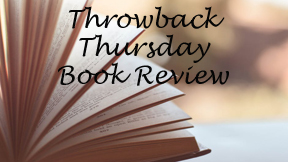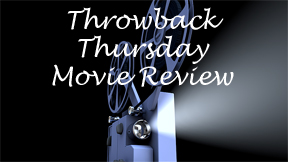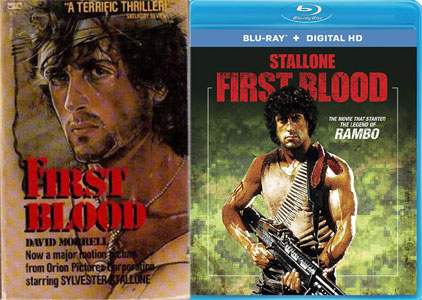With “Rambo: Last Blood” – Sylvester Stallone’s supposedly last (haha) go-around with the famous Vietnam veteran — hitting theaters this week, I’m taking a look back at the stories that started it all: David Morrell’s 1972 novel “First Blood,” and the movie adaptation that came a decade later:
“First Blood” (1972 novel)
Morrell’s “First Blood” shares enough commonalities with the movie that we can see it inspired the filmmakers as a jumping-off point; the film also takes set pieces from the book but then comes up with its own action sequences.
In the book, when war veteran John Rambo passes through a small Kentucky town, he’s confronted by Sheriff Teasle, who wants him to keep moving, never come back, and have a nice day now ya hear. A cat-and-mouse game ensues, and Trautman – the colonel at Rambo’s training camp – comes into the picture later.

Morrell’s book, written in an anti-literary yet easy flowing style, becomes an intensely personal battle of strategy and wits between Rambo and Teasle. The author brings us into the heads of both, with Rambo thinking maybe I didn’t have to fight back but goddammit I’m not gonna be pushed around anymore, and Teasle thinking maybe I could’ve eased off but goddammit this town will go to the druggies if I’m not stern with the longhairs.
Teasle thinks of Rambo as “the kid,” since he doesn’t learn his name till well into the book. It’s impossible to not picture Stallone when reading Morrell’s words, but before the movie came out, people were perhaps picturing less of a grown man.
Pushed to the extreme
The steadily ratcheting “First Blood” is about the extreme lengths a human body can be pushed to before it breaks. It’s not realistic on the whole, but the details are superb as Morrell lets us into the minds of two men who are slowly dying and going crazy.
He also suggests the mind is capable of a next level of evolution if pushed far enough, as Teasle’s mind links with Rambo’s. This might be too much for some readers, but I think it’s the right amount of crazy.
There’s less of an “out” for Rambo here than in the movie. Even though he’s sympathetic – a guy who wouldn’t hurt a fly as long as it left him alone – he does commit a murder that’s not in self-defense in the first of an epic string of kills.
While a lot of the book takes place in the woods, there’s also a harrowing cave sequence like something out of “The Descent,” as well as car chases and exploding buildings.
There are ridiculous moments such as Teasle’s ability to shoot out headlights and tires even when totally exhausted, but overall it’s clear Morrell has experience with survival tactics and war – or is good at faking it. His description of Rambo hiding in mud is so evocative that the “Rambo: First Blood Part II” filmmakers borrowed the idea.

Morrell explores gray areas
There’s no big final speech from Rambo. In fact, in this book’s narrative, Rambo and Trautman never meet face-to-face their whole lives. While this isn’t an incendiary anti-war novel, Trautman has a fascinating outlook on the topic: He hates war (like any sane person); as such, he trains soldiers so they can live, not so they can kill.
Rambo is the good guy, and Teasle is in the wrong. That’s never in doubt. But Morrell wades hip-deep into gray areas — Rambo worries that he enjoys killing, for example – intent on asking if you can sympathize with anyone if you spend a day in their shoes.
But those are ultimately the book’s foundations, and it’s better for moving on from those ideas. Morrell is ultimately interested in a less well-trod topic: what hunting and being hunted does to people.
As the memorable final page makes clear, Morrell’s “First Blood” is not intended to be a franchise-launcher (even though he’d go on to write novelizations of the next two movies in the series): It’s a novel of headlong inevitability, about two men who can’t stop even though they regularly entertain the notion.
4 stars
“First Blood” (1982 movie)
The “First Blood” screenwriters — Michael Kozoll, William Sackheim and Stallone – adapt about 75 percent of the novel’s action faithfully, but they lean into Rambo’s status as a Vietnam veteran a lot more. The Rambo-versus-Teasle (Brian Dennehy) element is still present, and the sheriff’s second-in-command, Galt (Jack Starrett), is actually even more desperate to claim Rambo’s scalp.
But the small-town Oregon cops generally respect Rambo more, with Mitch (David Caruso) openly marveling when he learns Rambo is a Green Beret with a Congressional Medal of Honor. Rambo is not the pigeon being chased by cats; he’s the cat chasing the pigeons.
In addition to what we see on screen – starting with a great sequence where Rambo takes out deputies using homemade traps and trickery — several lines of dialog remind us who is really in control. Rambo tells Teasle that Teasle is the law in town, but Rambo is the law in the woods. (He is actually being modest; Rambo is in control in the town later on, too.)

“First Blood” (1982)
Director: Ted Kotcheff
Writers: Michael Kozoll, William Sackheim, Sylvester Stallone
Stars: Sylvester Stallone, Brian Dennehy, Richard Crenna
And Colonel Trautman (Richard Crenna) warns Teasle about escalating the situation by sending 200 men after Rambo; if he sends that many, he’ll need to remember to bring a good supply of body bags.
Rambo shows mercy
Amazingly, Rambo doesn’t kill anyone in “First Blood,” although Teasle blames him for Galt’s deadly fall from a helicopter. This is perhaps filmic convenience, and in fact Rambo almost pays the price for his mercy on a couple of occasions. If he did kill some of those cops in the woods, would he be the villain rather than the hero? I don’t think it’s that simple.
The bulk of director Ted Kotcheff’s “First Blood” is an all-American, red-meat 1980s action movie, with the aforementioned traps and one-liners. But the narrative is always funneling toward Rambo’s famous closing speech that specifically critiques the Vietnam War. Teasle’s first comment to Rambo as he drifts through town is about his jacket: People around these parts won’t take kindly to that American flag patch.
In a delicious bit of irony, Teasle’s sheriff’s jacket also includes an American flag emblem, as of course most law enforcement uniforms do. It’s a nice way to illustrate the strange conflict between the federal military and local law enforcement. Seemingly, they should be on the same side, but they are often at odds.
“First Blood” is sometimes a tonally schizophrenic film, including some performances only a notch away from self-parody, notably the weekend warriors who ham it up during and after blowing up the mine shaft entrance. It’s also noteworthy that Crenna doesn’t change his performance all that much when essentially reprising this role for “Hot Shots!” (1991).
Powerful themes
That said, “First Blood” never wavers from its themes: First, it shows how law enforcement can easily cause a problem, and there’s not much of a legal check when it does so. (Teasle unconvincingly argues that if Rambo had a problem with how the deputies were treating him, well, he could’ve complained to Teasle rather than breaking out of jail.)
Second are the problems soldiers face in re-acclimating to a society that aggressively (and bizarrely) doesn’t want them to re-acclimate. Even if you watch “First Blood” on mute, this theme would come through visually; one of my favorite shots is the ammo-strapped Rambo running through streets illuminated by signs for Dairy Queen and other 20th century Americana.
“First Blood” is a nutshell version of the confusion of the Vietnam War, and the stark eye-opener for soldiers who returned only to be spat on by their fellow Americans. Today, perhaps in a corrective measure to that sad period, many citizens view soldiers and the wider military as two distinct entities.
This has its own set of problems, though, as illustrated in Rambo’s speech, where he says he can’t stop thinking about the war, specifically an incident where his friend is begging to go home and Rambo wonders how that can happen since he can’t find his friend’s legs.
It’s a stark illustration of PTSD (although, obviously, not the only way PTSD can manifest). Rambo’s speech clinches “First Blood” as a great movie, even if it’s the least subtle statement of the whole 93 minutes. What Rambo says is harrowing, but it’s the pain that spills out with his words that speaks volumes. Actors have won Academy Awards for a lot less than what Stallone does throughout this film, and specifically in that scene.
5 stars

